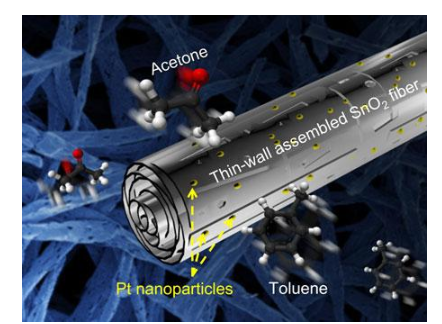What are the five major material technologies for manufacturing nanosensors?
1. Nanosensor based on nanoparticles and nanoclusters
Nanoparticles (mainly precious metal particles) have excellent size-related optical properties, which have been used to construct optical nanosensors.
The spectrum of the phenomenon called local surface plasmon resonance (LSPR) depends on the size, shape and material of the nanoparticle itself and the environment of the particle. The high sensitivity of the LSPR sensor can approach the single molecule detection limit of large biological molecules.
In addition to metal nanoparticles, optical nanosensors based on fluorescence measurement have been constructed using semiconductor quantum dots, and other optical sensors have also been developed using nanoscale probes. These probes contain dyes that are quenched in the presence of the analyte to be measured. Extinct. Nanoparticle films have been used in gas sensors. Magnetic nanoparticles combined with biological recognition molecules (ie DNA, enzymes, etc.) have been used to enrich the analytes to be detected.
For example, researchers have developed an enzyme biomarker test based on gold nanoparticles that can detect enzyme markers for diseases called proteases in humans, animals, and food. The nanosensor indicates when the protease is present through a visible color change reaction.
Gold nanoparticles covered with casein. There are proteases, which "engulf" the protective barrier of casein, exposing the surface of gold nanoparticles
2. Nano sensors based on nanowires, nanofibers and carbon nanotubes
Most carbon nanotube (CNT)-based sensors are field-effect transistors (FET), because although CNTs are strong and inert, their electrical properties are extremely sensitive to the effects of charge transfer and chemical doping of various molecules. The functionalization of CNTs is very important to make them selective for the target analyte-different types of sensors are based on the molecular recognition interaction between the functional CNT and the target analyte.
For example, researchers have developed a flexible hydrogen sensor made of single-walled carbon nanotubes decorated with palladium nanoparticles.
Nanowires and nanofibers have also been used to construct chemical sensors to diagnose diseases. They have been used to maximize the gas sensor response in breath analysis to detect volatile organic compounds (volatile organic compounds are biomarkers for various diseases; for example, acetone, hydrogen sulfide, ammonia, and toluene can be used to assess diabetes , Biomarkers of bad breath, renal insufficiency and lung cancer).
In one example, porous tin oxide nanofibers have been shown to detect acetone levels of about 0.1 ppm, which is eight times lower than the gas sensing level required to diagnose diabetes.

Ultra-fast acetone sensor uses thin-wall assembled tin oxide nanofibers functionalized by catalytic Pt nanoparticles to diagnose diabetes
3. graphene-based nano sensor
Another carbon nanomaterial, functionalized graphene, has extraordinary prospects in biological and chemical sensors. Researchers have shown that the unique 2D structure of graphene oxide (GO) combined with its super permeability to water molecules causes sensing devices to operate at an unprecedented speed ("Ultra-fast graphene sensor monitors your breathing while you speak ").
Scientists have discovered that chemical vapors can change the noise spectrum of graphene transistors, allowing them to perform selective gas sensing of multiple vapors through a device made of raw graphene-without the need to functionalize the graphene surface (" Raw graphene for selective gas sensing").
Researchers have also begun to study graphene foam, the three-dimensional structure of interconnected graphene sheets with extremely high electrical conductivity. These structures are very promising as gas sensors and biosensors for detecting diseases.
4. Nanosensors based on bulk nanostructured materials
Although several properties of nanoparticles can be used in nanosensors, their catalytic performance is one of the most important properties for electrochemical sensing devices. For example, it is reported that platinum nanoparticles supported on porous carbon or noble metals such as gold are related to the design of gas diffusion electrodes.
Their high surface area is another feature that makes nanoparticles suitable for immobilizing molecules, polymers or coatings of biological materials, so that composite materials with tunable surface properties can be generated. For example, modifying metal nanoparticles with pre-designed receptor units and assembling them on the surface may lead to new electrochemical sensors with customized specificity.
Simple and highly selective electroanalysis procedures can also be achieved through proper functionalization of nanoparticles. Finally, stable nanoparticles can replace amplified markers with limited stability, such as enzymes or liposomes, with equivalent or improved sensitivity.
5. Nano sensor based on metal organic framework (MOF)
The metal-organic framework (MOF) is an organic-inorganic hybrid crystalline porous material, composed of a regularly arranged array of positively charged metal ions and surrounded by organic "linker" molecules. The metal ions form nodes that hold the arms of the joint together to form a repeating cage structure. Due to this hollow structure, MOF has a very large internal surface area, which makes it an ideal material for gas sensing.
By making MOFs from different metal atoms and organic linking groups, researchers can create materials that can selectively absorb specific gases into special bags within the structure.
An example is a tailor-made MOF film coated on the electrode, which forms an electronic sensor that can detect trace amounts of sulfur dioxide gas.
Sulfur dioxide molecules (red and yellow) are selectively absorbed by the pores in the metal organic framework.
This article is from Allicdata Electronics Limited which offer electronic components, semiconductors, antennas, capacitors, connectors, diodes, transistors, IC,resistors. For more product information, please go to the website to get it.

